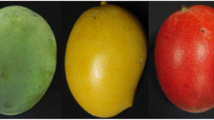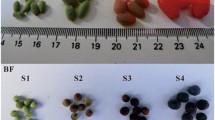Abstract
Accumulation of lycopene in citrus fruits is an unusual feature restricted to selected mutants. Grapefruit (Citrus paradisi Macf.) is the Citrus specie with greater number of red-fleshed mutants, but the molecular bases of this alteration are not fully understood. To gain knowledge into the mechanisms implicated in this alteration, we conducted a comparative analysis of carotenoid profile and of the expression of genes related to carotenoid biosynthesis and catabolism in flavedo and pulp of two grapefruit cultivars with marked differences in colouration: the white Marsh and the red Star Ruby. Mature green fruit of Marsh accumulated chloroplastic carotenoids, while mature tissues lacked carotenoids. However, accumulation of downstream products such as abscisic acid (ABA) and expression of its biosynthetic genes, 9-cis-epoxycarotenoid dioxygenase (NCED1 and NCED2), increased after the onset of colouration. In contrast, red grapefruit accumulated lycopene, phytoene and phytofluene, while ABA content and NCED gene expression were lower than in Marsh, suggesting a blockage in the carotenoid biosynthetic pathway. Expression analysis of three genes of the isoprenoid pathway and nine of the carotenoid biosynthetic pathway revealed virtually no differences in flavedo and pulp between both genotypes, except for the chromoplast-specific lycopene cyclase 2 (β-LCY2) which was lower in the pulp of the red grapefruit. The proportion in the expression of the allele with high (β-LCY2a) and low (β-LCY2b) activity was also similar in the pulp of both genotypes. Therefore, results suggest that reduced expression of β-LCY2 appears to be responsible of lycopene accumulation in the red Star Ruby grapefruit.








Similar content being viewed by others
References
Alós E, Cercós M, Rodrigo MJ, Zacarías L, Talón M (2006) Regulation of color break in citrus fruits. Changes in pigment profiling and gene expression induced by gibberellins and nitrate, two ripening retardants. J Agric Food Chem 54:4888–4895
Alquezar B, Rodrigo MJ, Zacarías L (2008a) Carotenoid biosynthesis and their regulation in citrus fruits. Tree and Forestry Science and Biotechnology 2:23–35
Alquezar B, Rodrigo MJ, Zacarias L (2008b) Regulation of carotenoid biosynthesis during fruit maturation in the red-fleshed orange mutant Cara Cara. Phytochem 69:1997–2007
Alquezar B, Zacarias L, Rodrigo MJ (2009) Molecular and functional characterization of a novel chromoplast-specific lycopene β-cyclase from Citrus and its relation to lycopene accumulation. J Exp Bot 60:1783–1797
Aung LH, Houck LG, Norman SM (1991) The abscisic acid content in Citrus with special reference to lemons. J Exp Bot 42:1083–1088
Ballester AR, Lafuente MT, Gonzalez-Candelas L (2006) Spatial study of antioxidant enzymes, peroxidase and phenylalanine ammonia-lyase in the citrus fruit–Penicillium digitatum interaction. Postharvest Biol and Technol 39:115–124
Banet E, Romojaro F, Llorente S (1981) Evolucion de pigmentos fotosinteticos en flavedo y pulpa de pomelo Marsh. Anales de Edafologia y Agrobiologia 40:259–267
Brandi F, Bar E, Mourgues F, Horvath G, Turcsi E, Giuliano G, Liverani A, Tartarini S, Lewinsohn E, Rosati C (2011) Study of 'Redhaven' peach and its white-fleshed mutant suggests a key role of CCD4 carotenoid dioxygenase in carotenoid and norisoprenoid volatile metabolism. BMC Plant Biol 11:24
Chen C, Costa MCG, Yu Q, Moore GA, Gmitter FG Jr (2010) Identification of novel members in sweet orange carotenoid biosynthesis gene families. Tree Genetics and Genomes 6:905–914
Corazza Nunes MJ, Machado MA, Nunes WMC, Cristofani M, Targon MLPN (2002) Assessment of genetic variability in grapefruits (Citrus paradisi Macf.) and pummelos (C. maxima (Burm.) Merr.) using RAPD and SSR markers. Euphytica 126:169–176
Costa M, Moreira C, Melton J, Otoni W, Moore G (2011) Characterization and developmental expression of genes encoding the early carotenoid biosynthetic enzymes in Citrus paradisi. Mol Biol Rep 39:1–8
Curl AL, Bailey GF (1957) The carotenoids of Ruby Red grapefruit. Food Res 22:63–68
Davies BH (1976) Carotenoids. In: Goodwin TW (ed). Chemistry and biochemistry of plant pigments, Vol.II. Academic Press, New York, pp 38-165
Fanciullino AL, Cercós M, Dhuique Mayer C, Froelicher Y, Talón M, Ollitrault P, Morillon R (2008) Changes in carotenoid content and biosynthetic gene expression in juice sacs of four orange varieties (Citrus sinensis) differing in flesh fruit color. J Agric Food Chem 56:3628–3638
Fanciullino AL, Dhuique Mayer C, Luro F, Casanova J, Morillon R, Ollitrault P (2006) Carotenoid diversity in cultivated citrus is highly influenced by genetic factors. J Agric Food Chem 54:4397–4406
Garcia-Lor A, Curk F, Snoussi-Trifa H, Morillon R, Ancillo G, Luro F, Navarro L, Ollitrault P (2013) A nuclear phylogenetic analysis: SNPs, indels and SSRs deliver new insights into the relationships in the 'citrus fruit trees' group (Citrinae, Rutaceae) and the origin of cultivated species. Ann Bot 111:1–19
Gmitter FG (1995) Origin, evolution and breeding of the grapefruit. Plant Breed Rev 13:345–363
Gmitter FG Jr, Chen CX, Machado MA, de Souza AA, Ollitrault P, Froehlicher Y, Shimizu T (2012) Citrus genomics. Tree Genet Genomes 8:611–626
Gross J (1987) Pigments in fruits. Academic Press, London
Kato M (2012) Mechanism of carotenoid accumulation in Citrus fruits. J Japan Hort Sci 81:219–233
Kato M, Ikoma Y, Matsumoto H, Sugiura M, Hyodo H, Yano M (2004) Accumulation of carotenoids and expression of carotenoid biosynthetic genes during maturation in citrus fruit. Plant Physiol 134:824–837
Kato M, Matsumoto H, Ikoma Y, Okuda H, Yano M (2006) The role of carotenoid cleavage dioxygenases in the regulation of carotenoid profiles during maturation in citrus fruit. J Exp Bot 57:2153–2164
Khan M, Mackinney G (1953) Carotenoids in grapefruit, Citrus paradisi. Plant Physiol 28:550–552
Ladaniya MS (2008) Fruit biochemistry. In: Ladaniya MS (ed) Citrus fruits: biology, technology and evaluation. Academic Press, San Diego, pp 125–190
Lafuente MT, Martinez Tellez MA, Zacarías L (1997) Abscisic acid in the response of 'Fortune' mandarins to chilling. Effect of maturity and high-temperature conditioning. J Sci Food Agric 73:494–502
Lee HS (2001) Characterization of carotenoids in juice of red navel orange (Cara Cara). J Agric Food Chem 49:2563–2568
Li L, Lu S, Cosman KM, Earle ED, Garvin DF, O’Neill J (2006) β-Carotene accumulation induced by the cauliflower Or gene is not due to an increased capacity of biosynthesis. Phytochem 67:1177–1184
Liu Q, Xu J, Liu Y, Zhao X, Deng X, Guo L, Gu J (2007) A novel bud mutation that confers abnormal patterns of lycopene accumulation in sweet orange fruit (Citrus sinensis L. Osbeck). J Exp Bot 58:4161–4171
Lu S, Van Eck J, Zhou X, Lopez AB, O’Halloran DM, Cosman KM, Conlin BJ, Paolillo DJ, Garvin DF, Vrebalov J, Kochian LV, Kupper H, Earle ED, Cao J, Li L (2006) The cauliflower Or gene encodes a DnaJ cysteine-rich domain-containing protein that mediates high levels of β-carotene accumulation. Plant Cell 18:3594–3605
Matlack MB (1935) Pigments of pink Grapefruit, Citrus grandis (L., Osbeck). J Biol Chem 110:249–253
Matsumoto H, Ikoma Y, Kato M, Kuniga T, Nakajima N, Yoshida T (2007) Quantification of carotenoids in Citrus fruit by LC-MS and comparison of patterns of seasonal changes for carotenoids among Citrus varieties. J Agric Food Chem 55:2356–2368
Matsumoto H, Ikoma Y, Kato M, Nakajima N, Hasegawa Y (2009) Effect of postharvest temperature and ethylene on carotenoid accumulation in the flavedo and juice sacs of 'Satsuma' mandarin (Citrus unshiu Marc.) fruit. J Agric Food Chem 57:4724–4732
Mendes AFS, Chen C, Gmitter FG, Moore GA, Costa MGC (2011) Expression and phylogenetic analysis of two new lycopene β-cyclases from Citrus paradisi. Physiol Plant 141:1–10
Monselise SP, Halevy AH (1961) Detection of lycopene in pink orange fruit. Science 133:1478
Nicolosi E, Deng ZN, Gentile A, La Malfa S, Continella G, Tribulato E (2000) Citrus phylogeny and genetic origin of important species as investigated by molecular markers. Theor Appl Genet 100:1155–1166
Ohmiya A, Kishimoto S, Aida R, Yoshioka S, Sumitomo K (2006) Carotenoid cleavage dioxygenase (CmCCD4a) contributes to white color formation in Chrysanthemum petals. Plant Physiol 142:1193–1201
Pascual M, Mallent MD, Cuñat P (1993) Estudio de los carotenoids de naranjas Navelina. Rev Española de Ciencia y Tecnologia de Alimentos 33:179–196
Pfaffl MW, Horgan GW, Dempfle L (2002) Relative expression software tool (REST-®) for group-wise comparison and statistical analysis of relative expression results in real-time PCR. Nucl Acids Res 30:e36
Rao A, Rao LG (2007) Carotenoids and human health. Pharmacol Res 55:207–216
Rodrigo MJ, Alquézar B, Zacarías L (2006) Cloning and characterization of two 9-cis-epoxycarotenoid dioxygenase genes, differentially regulated during fruit maturation and under stress conditions, from orange (Citrus sinensis L. Osbeck). J Exp Bot 57:633–643
Rodrigo MJ, Marcos JF, Alférez F, Mallent MD, Zacarías L (2003) Characterization of Pinalate, a novel Citrus sinensis mutant with a fruit-specific alteration that results in yellow pigmentation and decreased ABA content. J Exp Bot 54:727–738
Rodrigo MJ, Marcos JF, Zacarías L (2004) Biochemical and molecular analysis of carotenoid biosynthesis in flavedo of orange (Citrus sinensis L.) during fruit development and maturation. J Agric Food Chem 52:6724–6731
Rodrigo MJ, Zacarías L (2006) Effect of postharvest ethylene treatment on carotenoid accumulation and the expression of carotenoid biosynthetic genes in the flavedo of orange (Citrus sinensis L. Osbeck) fruit. Postharvest Biol Technol 43:14–22
Romero P, Lafuente MT, Rodrigo MJ (2012) The Citrus ABA signalosome: identification and transcriptional regulation during sweet orange fruit ripening and leaf dehydration. J Exp Bot 63:4931–4945
Romojaro F, Banet E, Llorente S (1979) Carotenoids in both flavedo and pulp of Marsh seedless grapefruit. Revista de Agroquimica y Tecnologia de Alimentos 19:385–392
Saunt J (2000) Citrus varieties of the world. Sinclair International Limited, Norwich, pp 16–17
Stewart I, Wheaton TA (1972) Carotenoids in citrus—their accumulation induced by ethylene. J Agric Food Chem 20:448–449
Ting SV, Deszyck EJ (1958) The internal color and carotenoid pigments of Florida red and pink grapefruit. J Amer Soc Hort Sci 71:271–277
Tomes ML, Quackenbuss FW, Kargill TE (1956) Carotenoid synthesis in Citrus. Bot Gaz 117:1721–1724
Xu CJ, Fraser PD, Wang WJ, Bramley P (2006a) Differences in the carotenoid content of ordinary citrus and lycopene-accumulating mutants. J Agric Food Chem 54:5474–5481
Xu J, Tao NG, Liu Q, Deng XX (2006b) Presence of diverse ratios of lycopene/β-carotene in five pink or red-fleshed citrus cultivars. Sci Hortic 108:181–184
Yokoyama H, Debenidi C, Coggins CW, Henning GL (1972) Chemical regulation of carotenoid biosynthesis. 3. Induced color changes in grapefruit and orange. Phytochem 11:1721–1724
Yokoyama H, White MJ (1967) Carotenoids in the flavedo of Marsh seedless grapefruit. J Agric Food Chem 15:693–696
Yu K, Xu Q, Da X, Guo F, Ding Y, Deng X (2012) Transcriptome changes during fruit development and ripening of sweet orange (Citrus sinensis). BMC Genomics 13:10
Zacarias L, Talon M, Ben C, Lafuente MT, Primo-Millo E (1995) Abscisic acid increases in non-growing and paclobutrazol-treated fruits of seedless mandarins. Physiol Plant 95:613–619
Zhang L, Ma G, Shirai Y, Kato M, Yamawaki K, Ikoma Y, Matsumoto H (2012) Expression and functional analysis of two lycopene β-cyclases from citrus fruits. Planta 236:1315–1325
Acknowledgments
We acknowledge Dr. L. Gonzalez-Candelas (IATA-CSIC, Valencia) for providing the plasmids with MEP probes. We thank Dr. L. Navarro (IVIA, Moncada, Valencia) for the use of the Citrus Germplasm Bank. The technical assistance of Amparo Beneyto is gratefully acknowledged. This work has been supported by research grants AGL2009-11558 and AGL-2012-34573 (Ministerio de Ciencia e Innovación and Economia y Competitividad, Spain). Joanna Lado is the recipient of a JAE-pre-fellowship from CSIC (Fondo Social Europeo). Financial support by PROMETEO2010/010 (Generalitat Valenciana) and Fun-C-Food (CSD2007-0063C, Ministerio de Ciencia e Innovación) is also acknowledged.
Author information
Authors and Affiliations
Corresponding author
Additional information
Communicated by W.-W. Guo
Rights and permissions
About this article
Cite this article
Alquezar, B., Rodrigo, M.J., Lado, J. et al. A comparative physiological and transcriptional study of carotenoid biosynthesis in white and red grapefruit (Citrus paradisi Macf.). Tree Genetics & Genomes 9, 1257–1269 (2013). https://doi.org/10.1007/s11295-013-0635-7
Received:
Revised:
Accepted:
Published:
Issue Date:
DOI: https://doi.org/10.1007/s11295-013-0635-7




